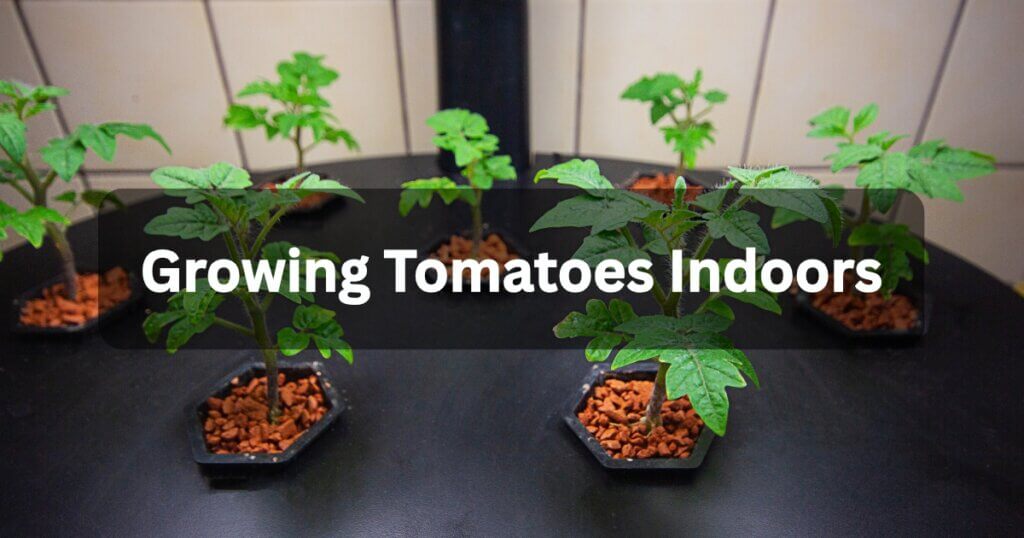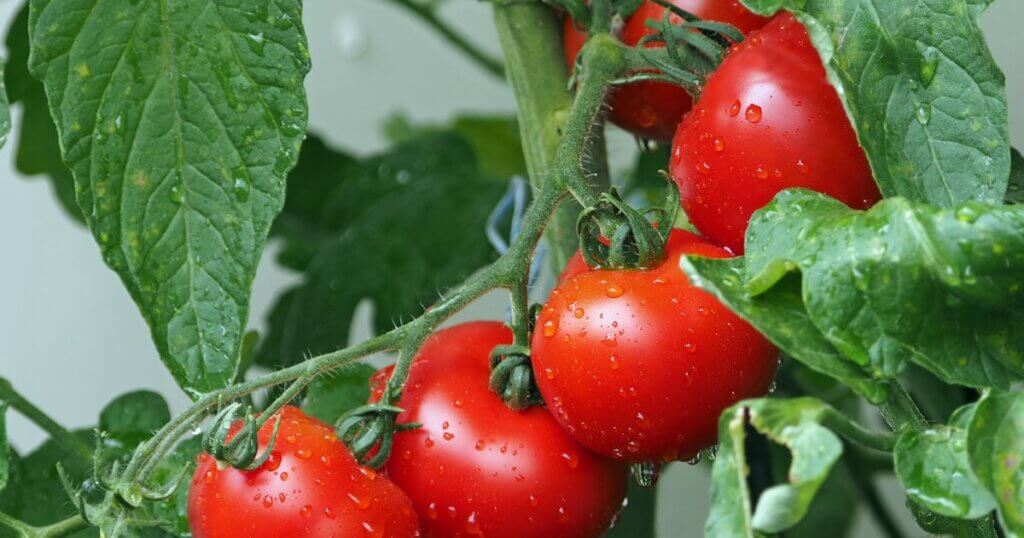The Ultimate Guide to Growing Tomatoes Indoors: Juicy Harvests All Year Long

Some of the links in this post are affiliate links. As an Amazon Associate, we earn a referral fee from qualifying purchases—at no extra cost to you.
Imagine biting into a sweet, sun-kissed tomato… in the middle of winter. Sounds impossible? Not if you’re growing tomatoes indoors. Whether you live in a city apartment or a snowy suburb, indoor tomato gardening lets you enjoy fresh, flavorful fruit every single day—no backyard required.
If you’re wondering whether you can actually pull it off, the answer is a big, juicy YES. This guide will walk you through everything from choosing the right seeds to harvesting ripe tomatoes right from your kitchen window.
Table of Contents
Why Growing Tomatoes Indoors Is a Game-Changer
Growing tomatoes indoors isn’t just a trend—it’s a full-blown lifestyle upgrade. You get pesticide-free produce, total control over your growing conditions, and a satisfying hobby rolled into one. Plus, indoor gardening helps you cut grocery costs and eliminates the seasonal limitations of outdoor crops. With a bit of patience and the right setup, you’ll have tomatoes year-round.
What Makes Tomatoes Perfect for Indoor Growing?
Tomatoes are relatively fast-growing, adaptable, and they thrive in controlled environments. Many compact and dwarf varieties are bred specifically for small spaces. Their bright green foliage adds a splash of nature indoors, while their continuous flowering and fruiting can be incredibly rewarding. The key? Giving them what they need in terms of light, warmth, and care.
Choosing the Best Tomato Varieties for Indoor Gardening
Determinate vs. Indeterminate Tomatoes
- Determinate varieties grow to a fixed size and produce fruit all at once. Great for limited space.
- Indeterminate varieties keep growing and fruiting for months. They need staking and more care but can yield longer harvests.
Top Tomato Varieties for Indoor Success
- Tiny Tim: A dwarf cherry tomato that thrives in containers.
- Balcony: Perfect for tight spaces.
- Patio Princess: Compact and prolific.
- Bush Early Girl: Fast-growing with juicy fruits.
Mars Hydro Full‑Spectrum LED Grow Light
A high‑efficiency, full-spectrum LED tailored for fruiting plants—perfect for delivering the 8–10 hours of quality light tomatoes need indoors.
Getting Started: Indoor Tomato Growing Essentials
Light Requirements for Indoor Tomatoes
Tomatoes love sunlight—at least 8 to 10 hours a day. Natural light is ideal, but unless you have a sun-drenched room, you’ll need grow lights.
Choosing the Right Grow Lights for Tomatoes
LED grow lights are energy-efficient and ideal for tomatoes. Look for full-spectrum lights with a PAR rating that supports fruiting. Mount them 12–18 inches above the plants for best results.
Ideal Temperature and Humidity Conditions
Tomatoes thrive between 70°F–80°F (21°C–27°C) during the day and about 60°F–70°F (16°C–21°C) at night. Keep humidity between 40%–70% to prevent fungal issues and promote healthy growth.
Best Containers and Potting Mix for Growing Tomatoes Indoors
How to Choose the Right Pot Size
Tomato plants need room for their roots. Choose containers that are at least 12 inches deep. Self-watering pots are a bonus for consistency.
Self‑Watering Planter
Stylish, compact, and equipped with a water reservoir—ideal for maintaining consistent moisture in tomato pots.
Soil vs. Soilless Growing Mediums
- Soilless mixes (like coco coir + perlite) are light and disease-free.
- Organic potting mixes work too—just make sure they drain well and contain compost.
How to Plant Tomato Seeds Indoors Like a Pro
Seed Starting Tips and Tricks
Start your seeds in small trays or cups using a light, moistened seed-starting mix, which helps delicate roots grow easily. Maintain warmth around 75°F (24°C), and cover the containers with plastic wrap to create a mini-greenhouse that retains moisture and heat. Most seeds will germinate in 5–10 days, depending on the plant variety. Once your seedlings have grown two true leaves, they’re ready for transplanting into larger pots.
Transplanting Seedlings to Larger Pots
Handle young seedlings gently when transplanting to avoid damaging their roots. Wait until they’re about 4–6 inches tall and sturdy enough to handle the move. When placing them in new pots, bury the stem slightly deeper than before—this encourages the development of extra roots for better stability and nutrient uptake. Water lightly after transplanting to help the roots settle into their new environment.
Indoor Tomato Plant Care Tips for Big Yields
Pruning and Staking Tips for Compact Spaces
In small indoor gardens, pruning helps your plants stay healthy and productive. Remove suckers—the small shoots that grow between the main stem and branches—to direct the plant’s energy toward producing fruit rather than excess foliage. For support, use compact options like bamboo stakes or tomato cages, especially for indeterminate varieties that grow tall and vine-like. These methods keep plants tidy, upright, and more manageable in limited space.
Managing Pollination Without Bees
Indoor farming lacks natural pollinators like bees, but you can manually pollinate to ensure fruit development. Gently shake your plants or use a small paintbrush to transfer pollen between flowers—this mimics the movement of insects. Doing this once a day during the flowering stage increases the chances of a higher yield. With just a few minutes of attention, you can boost production and keep your indoor crops thriving.
Harvesting Tomatoes Indoors: When and How
How to Know When Your Tomatoes Are Ripe
You’ll know your indoor tomatoes are ripe when they develop a rich, even color—whether red, yellow, or another variety-specific hue—and feel slightly soft to the touch. A sweet, earthy aroma near the stem is another good indicator. For the best flavor, let them ripen fully on the vine, but don’t wait too long, or they may split from over-ripeness. Harvesting at the right time ensures juicy texture and maximum sweetness.
Best Practices for Picking and Storing Indoor-Grown Tomatoes
When picking, twist the tomato gently from the vine to avoid damaging the plant or bruising the fruit. Store freshly harvested tomatoes at room temperature, out of direct sunlight, to maintain their full flavor and texture. Only refrigerate them if they’re very ripe and you can’t eat them right away—cold temperatures can dull their taste. Proper picking and storage keep your indoor tomatoes tasting garden-fresh for longer.
Smart Tools to Make Indoor Tomato Growing Easier
Automated Watering Systems
Drip irrigation kits or self-watering planters can save time and ensure consistency. Especially handy if you’re forgetful or travel often.
Climate Control Sensors and Grow Tents
Use smart sensors to track temp and humidity. Grow tents with built-in reflective walls and ventilation boost efficiency and yield.
Soil Temperature • Moisture • EC and NPK Sensor
A comprehensive sensor that tracks soil temperature, moisture, and nutrient levels—great for optimizing indoor conditions.
Creative Ideas to Maximize Your Indoor Tomato Harvest
Vertical Gardening Solutions
Vertical gardening is a game-changer for indoor growers with limited space. Stackable planters, wall-mounted shelves, and tiered systems allow you to grow upward instead of outward, making the most of your square footage. Hanging baskets are perfect for trailing herbs or leafy greens like strawberries and lettuce. With the right setup, even a small apartment wall can become a lush, productive garden.
Companion Planting Indoors
Companion planting isn’t just for outdoor gardens—it works wonders indoors too. Growing basil near tomatoes can enhance their flavor and support growth, while marigolds help deter pests naturally, even inside. These strategic pairings create healthier micro-environments, reducing the need for chemical interventions. It’s a smart, organic way to boost productivity and plant health in your indoor garden.
Conclusion
There you have it—the ultimate playbook for growing tomatoes indoors. With the right variety, a little setup, and some TLC, you can enjoy vine-ripened tomatoes all year long. Whether you’re a gardening newbie or a seasoned green thumb, indoor tomatoes bring freshness, flavor, and joy to any space.
So grab those seeds, fire up those grow lights, and get planting. Your first homegrown tomato is just weeks away!
FAQs – Growing Tomatoes Indoors
1. Can I grow tomatoes indoors without grow lights?
Yes, but it depends on your lighting conditions. Tomatoes need at least 8–10 hours of strong light daily, ideally from a south-facing window. Without that, your plants may become leggy and unproductive. In most cases, supplemental LED grow lights are highly recommended for healthy growth and consistent fruiting.
2. How long does it take to grow tomatoes indoors from seed to harvest?
On average, it takes 60–85 days from planting seeds to harvesting ripe fruit, depending on the variety. Dwarf and cherry types like ‘Tiny Tim’ mature faster, while larger varieties may take longer. Using optimal light, warmth, and nutrients can speed up the process slightly.
3. Can indoor tomato plants attract pests?
Yes, indoor tomato plants can still suffer from pests like aphids, whiteflies, or spider mites—especially if new plants or soil are brought in. Regular inspection, neem oil sprays, and maintaining good airflow can help prevent infestations. Sticky traps are also useful for monitoring flying pests.
4. Do indoor tomatoes taste as good as outdoor ones?
They absolutely can! With the right variety, full-spectrum lighting, and balanced nutrients, indoor tomatoes can be just as sweet and flavorful as garden-grown ones. In fact, many growers find that controlling every variable indoors can lead to even better taste consistency.
5. Can I keep an indoor tomato plant producing all year long?
Yes, especially with indeterminate varieties. As long as they receive consistent light, warmth, and care, they can keep flowering and fruiting for months—even year-round. Just be sure to prune regularly, feed with balanced fertilizer, and refresh the growing medium if needed.
Other Useful Resources Related To Growing Tomatoes Indoors
- Better Homes & Gardens: 10 Must-Know Tips for Growing Tomatoes Indoors
This article provides essential tips for successfully growing tomatoes indoors, including lighting requirements, best tomato varieties, and seed-starting techniques. - The Backyard Farmer: How to Grow Tomatoes Indoors – A Complete Guide
A comprehensive guide covering everything from choosing the right tomato varieties to troubleshooting common indoor growing issues. - Epic Gardening: Growing Tomatoes Indoors – Year-Round Fruit
This resource explains how to grow tomatoes indoors throughout the year, highlighting the benefits of indoor gardening and the best methods for success. - General Search for External Links on Growing Tomatoes Indoors
A search link to explore additional expert sources on indoor tomato gardening, including articles, forums, and research-backed insights. - Growing Tomatoes Indoors for Beginners: Complete Guide
This comprehensive guide covers everything from selecting the right tomato varieties to setting up an indoor garden space for year-round harvests.






